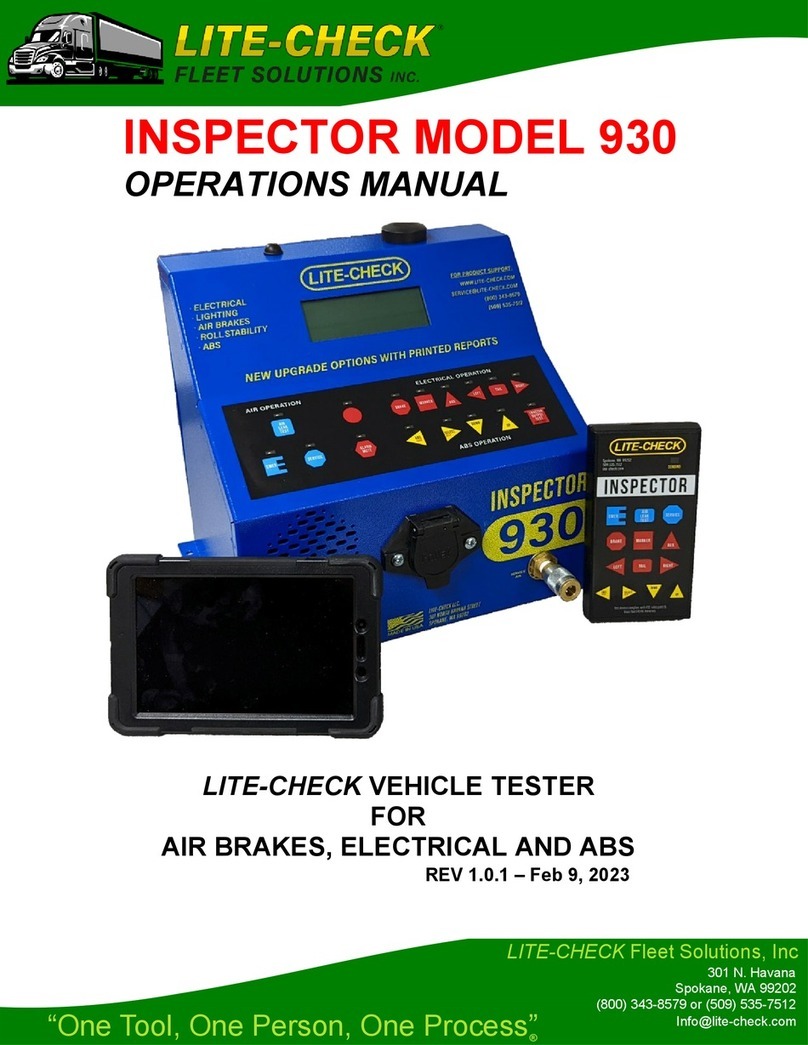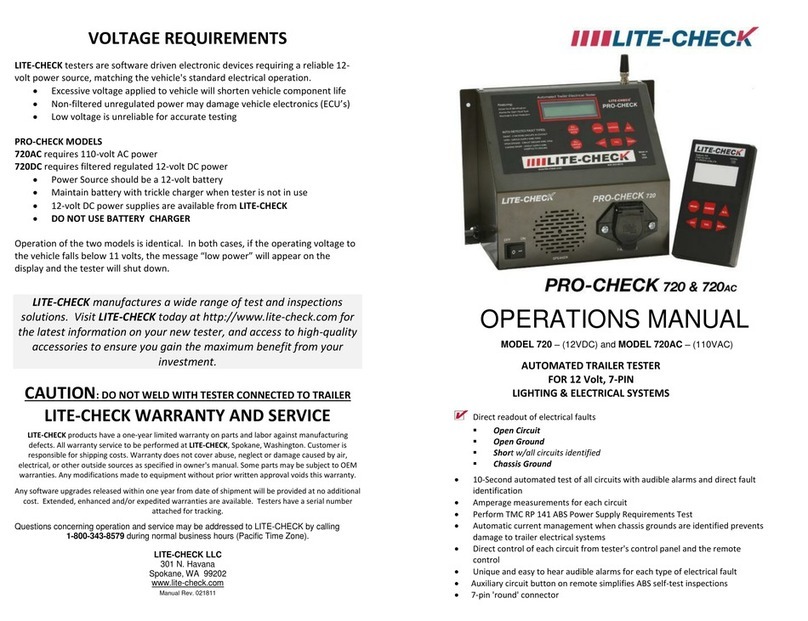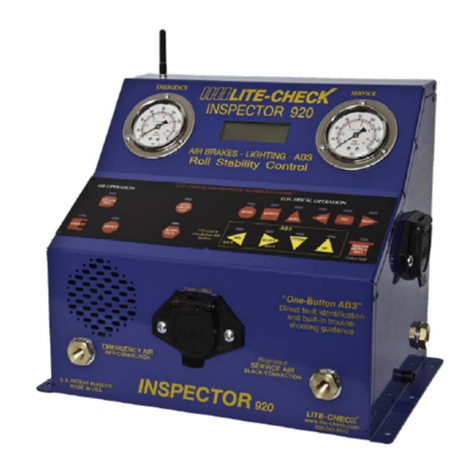
Table of Contents
Lite-Check CERTIFIER 1200 Operations Manual
COVER………………………………………………………………………………………..……..
CAUTIONS……………………………………………………………………………………..……
TABLE OF CONTENTS……………………………………………………………………….…..
LITE-CHECK CERTIFIER 1200..……………………………………………………………..…..
Description…………………………………………………………………………………………………..….
Key Features of the Certifier 1200...…………..…..….…...…..……...…..…..…….………………...…….
Set-up Requirements…………………………………………………………………………………….…….
MODEL 400 HUB AND DOLLY………….……….………….………………….………………..
Description………………………………………………………………………………………………….…..
Hub Status LEDs…………………………………………………………………………………………..…..
LITE-CHECK TABLET and DESCRIPTION……………………..……………………………..
LITE-CHECK MODEL 363 DIFFERENTIAL KIT…………………………………………….…
Description………………………………………………………………………………………………….…..
Contains…………………………………………………………………………………………………….…..
LITE-CHECK AIR PRESSURE SENSOR/TRANSDUCER and DESCRIPTION…………...
INITIAL SET-UP PROCEDURES………….…………………………………………………..….
Shop Set-up………………………………………………………………………………………………..……
1200 CERTIFIER SELF-TEST PROCEDURES………....……………………………..….……
Test 1: Internal Self-Leak Test Without a Trailer or Dolly……………………………..……………….….
Test 2: 121 Timing Self-Test Without a Trailer or Dolly……………………………………………………
Test 3: Brake differential Self-Test Without a Trailer or Dolly…………………………….……………….
TESTER OPERATION, GENERAL………………………………………………………..……..
General……………………………………………………………………………………………….….…….
Functions of Keys, Panel and Tablet ..…...…….…..……..….……..…….….………………….…………
Notes..…..…..…..….…..……………………..……..…………………………………………………………
VERIFY THE TABLET IS CHARGED AND FUNCTIONAL……………………………………
INTERPRETING PANEL DISPLAYS, INDICATORS AND ALARMS…….…………………
General…………………………………………………………………………………………………………
Switch Indicators, LED………………………………………………………………………………………..
Audio Alarms…………………………………………………………………………………………………..
LITE-CHECK CERTIFIER SOFTWARE………………………………………………………..
General…………………………………………………………………………………………………………
Upgrading Your LITE-CHECK CERTIFIER Software……………………………………….………………
PERFORMING TESTS ON AN ACTUAL TRAILER OR DOLLY………………………..……
Performing the Air Leak Test when Attached to a Trailer or Dolly………………….…..…………………
Performing the 121 Timing Test when Attached to a Trailer or Dolly……………………………………..
Performing the Service Brake Differential Pressure Test on a Trailer or Dolly………………………..…
Performing ABS Tests.….….….….……….…..….……………………………………….…………………..
WHAT YOU WILL SEE ON THE 1200 CERTIFIER GUI SCREENS………………..………..
Main 1200 Startup Screen (General Overview)..….….….……….….….….….….…….…………………
SETUP Testing “Controller Dropdown”..……...…..….…...….….…..…..….…….…..…..….….…………
SETUP Testing “Hub Dropdown”……………………………………………………………………….…….
SETUP Testing “Help Dropdown”……….….…..….……………………………….…………………..……
SETUP Testing “Settings Dropdown (Page 1 of 2)”…………………………….…………………………..
SETUP Testing “Settings Dropdown (Page 2 of 2)”…………………………………………………………
Automatically Running Tests (Page 1 of 3) Enter Info, select tests, start tests…………..………..……
Automatically Running Tests (Page 2 of 3) Electrical tests in Progress…………..……………………..
Automatically Running Tests (Page 3 of 3) Electrical test done, Air Leak test started.………..……….
Sensor setup for 121 Timing test and Differential test…..……….….….….……..……………………..…
121 Timing test passed.…..…..……….…….….….…..…….…...…..….….…..….…...….….……….……
Differential test while running……..…………….....…….…....…...…..…………………..………………....
Passed Differential test...….…..…………....……..…..….….…..…..….….…..…………...…….……....…
Results of Failed Differential test ………………..…..……….…..…...…..…..………………………….…
Summary page which shows after tests are completed………….…..…..…..………………………….…
1
2
3
5
5
5
5
6
6
6
7
7
7
7
8
8
8
9
10
11
13
15
15
15
15
16
16
16
16
16
17
17
17
18
18
19
21
23
24
24
25
26
27
28
29
30
31
32
33
34
35
36
37
37
38
3
































